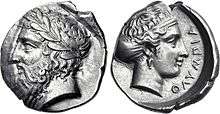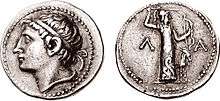Tetradrachm

The tetradrachm (Greek: τετράδραχμον) was an Ancient Greek silver coin equivalent to four drachmae.[1] In Athens it replaced the earlier "heraldic" type of didrachms and it was in wide circulation from ca. 510 to ca. 38 BC.[2]
History
The transition from didrachms to tetradrachms occurred during ca. 525–510 BC; the abandonment of the "heraldic"-type didrachms and the Archaic tetradrachms (early "owls") of the polis of Athens apparently took place shortly after the Battle of Salamis, 480 BC. This transition is supported by the discovery of contemporary coin hoards, and more particularly of a coin hoard found on the Acropolis in 1886.[3]
The Athenian tetradrachm was widely used in transactions throughout the ancient Greek world, including in cities politically unfriendly to Athens.[2] Athens had silver mines in state ownership, which provided the bullion. Most well known were the silver mines of Laurium at a close distance from Athens.[4] The Athenian tetradrachm was stamped with the head of Athena on the obverse, and on the reverse the image of the owl of Athena, the iconographic symbol of the Athenian polis, with a sprig of olive and a crescent for the moon. According to Philochorus, it was known as glaux (γλαύξ, little owl)[5] throughout the ancient world[6] and "owl" in present-day numismatics.[7] The design was kept essentially unchanged for over two centuries, by which time it had become stylistically archaic. To differentiate their currency from the rival coinage of Aegina using the Aeginetic stater of about 12.3 grams, Athens minted its tetradrachm based on the "Attic" standard of 4.3 grams per drachma. The vast number of "owls-tetradrachms" available those days mainly from the silver mines of Laurium financed the several achievements of Athens, such as the reconstruction of the Acropolis and building the Parthenon, as well as many wars, including the Peloponnesian War.
The tetradrachm's use as a currency was soon adopted by many other city-states of the ancient Greece, Asia Minor, Magna Grecia and other Greek colonial cities throughout the Mediterranean Sea. With the armies of Alexander the Great it spread to the Greek-influenced areas of present-day Iran and India.[8]
Gallery
_KBR_27-8-2016_11-45-16.)_KBR_27-8-2016_11-45-16.jpg) Tetradrachme of Aetna
Tetradrachme of Aetna Tetradrachm of Olympia
Tetradrachm of Olympia Tetradrachm of Sparta
Tetradrachm of Sparta.jpg) Tetradrachm of Abdera
Tetradrachm of Abdera Tetradrachm of Troy
Tetradrachm of Troy Tetradrachm of Kyme
Tetradrachm of Kyme Tetradrachm of Rhegion
Tetradrachm of Rhegion.jpg) Tetradrachm of Naxos
Tetradrachm of Naxos Tetradrachm of Cleopatra Thea
Tetradrachm of Cleopatra Thea Tetradrachm of Alexander the Great
Tetradrachm of Alexander the Great
See also
References
- ↑ "Tetradrachm". Merriam-Webster. Retrieved 2008-01-20.
- 1 2 Androulakis, Yiannis. "History of the Greek coins". Fleur-de-Coin. Retrieved 2008-01-20.
- ↑ Yannis Stoyas, Archaeologist – numismatist, The coij of Athens
- ↑ Aristotle, Athenian Constitution, 22.7
- ↑ γλαύξ, Liddell & Scott
- ↑ Philochorus: Scholion to Aristophanes, Birds 1106.
- ↑ Kraay, C.M. The archaic owls of Athens: classification and chronology.
- ↑ "Tetradrachm (silver)". Coin Cabinet. Kunsthistorisches Museum Vienna. Archived from the original on June 18, 2007. Retrieved 2008-01-20.
External links
| Wikimedia Commons has media related to Tetradrachm. |